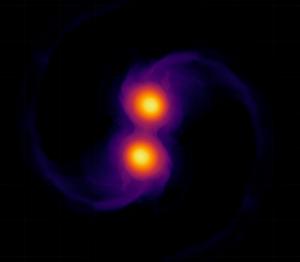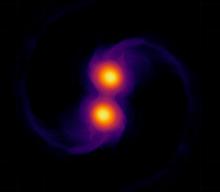Noisy Mergers [1]
A hypermassive neutron star defies gravity. Instead of instantly collapsing to form a black hole, it keeps itself puffed up. But only for a while. In the end, gravity always wins.
A neutron star is the ultra-dense corpse of a once mighty star. It’s more massive than the Sun, but smaller than the city limits of Chicago.
Neutron stars have a weight limit — about twice the mass of the Sun. If they pack on more, they collapse to form a black hole.
But there may be a way for a neutron star to hold up against that limit: from the merger of two neutron stars. If they come together in the right way, they might resist gravity by spinning extremely fast — up to 78 thousand times a minute.
That would churn up the surrounding space-time, producing tiny ripples known as gravitational waves. Future observatories should be able to “hear” those ripples as the stars approach each other, as depicted in this simulation. [audio]
The ripples would end with a “chirp” as the combined stars finally surrendered, forming a black hole. From merger to collapse, it should all be over in less than a second.
The black hole would “ring” like a bell for a while longer as it settled down, producing more waves. No one has yet “heard” that ringing. But a recent study found two candidate mergers from the 1990s. They were accompanied by intense bursts of gamma rays — bright flashes before the ultimate darkness.
More about gravitational waves tomorrow.
Script by Damond Benningfield


